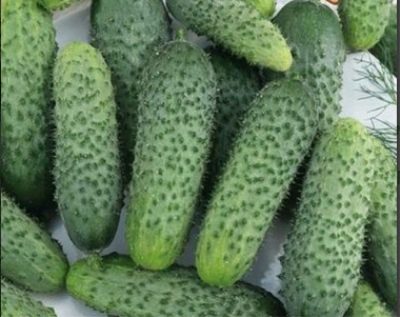
- Authors: S.V. Maksimov, N.N. Klimenko, L.A. Chistyakova (LLC "Agrofirma Poisk")
- Name synonyms: Veselaya semeyka
- Year of approval: 2017
- Growth type: vigorous, indeterminate
- Branching: the average
- Fruit weight, g: 90-120
- Fruit length, cm: 10-12
- Fruit color: green, with light short stripes
- Cucumber Mosaic Virus Resistance: stable
- Ripening terms: early
Cucumbers Merry family will appeal to those who like to make preparations for the winter. Cucumbers look nice in glass jars, harmonizing beautifully with different vegetables. At the same time, the plants are unpretentious, and also bear fruit abundantly.
Breeding history
The merry family F1 is a hybrid of the first generation, the result of the work of domestic breeders from the Moscow region agrofirm "Poisk" S. Maksimov, N. Klimenko, L. Chistyakova. A synonym for culture is Veselaya semeyka. Year of approval for use and entry into Rosreestr 2017.
Description of the variety
A hybrid variety of domestic selection with a cheerful name, it is distinguished by a bouquet arrangement of ovaries, high yields of delicious gherkins, and good resistance to sudden changes in temperature. The parthenocarpic type culture is suitable for both protected and open ground. Agrarians choose this variety due to its long keeping quality, as well as the excellent taste of both fresh fruits and those harvested for the winter.
Characteristics of the appearance of plants and zelents
A vigorous hybrid plant is distinguished by an indeterminate type of growth. The height of the main stem is on average one and a half meters, but it can grow up to 2-2.5 m. The bush is distinguished by moderate branching. In a hybrid variety of medium size, leaves of a green saturated color, rough.
Parthenocarpic bushes have inflorescences of only female type, their color is bright yellow.
The fruits of the Merry Family are formed in bunches of 5 ovaries. Gherkins grow up to 10-12 centimeters, and shorter ones can be removed - 7-9 cm. The weight of one cucumber is 90-120 grams.
The peel of the fruit is green, with light stripes on it, large tubercles are visible, as well as white thorns.
Purpose and taste of fruits
The taste of the fruits of the described hybrid is pleasant, the flesh of gherkins is juicy, with a pronounced cucumber aroma, without voids and bitterness. It is recommended to use the Merry Family cucumbers, first of all, for pickling, they are especially tasty in blanks. But gherkins are just as good for eating them fresh.
Maturation
The cheerful little family is an early ripening hybrid variety, the beginning of fruiting can be observed already 38-42 days after germination.
Yield
Average indicators of marketable crop yield - 11.5 kg / m2 of cucumbers.
Growing and care
The hybrid variety Veselaya Semeyka is grown throughout the country. However, depending on the climatic characteristics, agricultural technology is different.
So, in the northern or other regions with a cool climate, the variety is cultivated by the seedling method, in warmer regions, the seeds are sown on the garden bed. It can be grown in a greenhouse or in unprotected soil.
Seeds for growing seedlings with subsequent transplantation into a greenhouse are sown in early April, and for open beds - at the end of the month. Experts recommend taking peat pots for this, which are placed on a windowsill with good lighting. In open ground, seed should be sown in late May - early June. The landing pattern is 40x40 or 50x50 centimeters.
For planting the Veselaya Semeyka variety, it is important to correctly determine the land plot.You should not plant cucumbers in the beds where pumpkin or any melon crop was cultivated last season.
The hybrid variety of cucumbers The Merry Family is unpretentious, you just need to follow simple rules of agricultural technology, including standard measures such as watering, loosening, feeding, forming, preventing diseases and pest attacks.
For watering the culture, it is imperative to use only warm liquid 2-3 times a week. If it's hot, the cucumbers should be watered every day.
The hybrid is fertilized 2-3 times during the growing season, while complex mineral fertilizers and organic matter should be alternated. The main thing is that the plant must receive the necessary nutrients, such as nitrogen, potassium, phosphorus.
Ripe cucumbers should be removed. The Merry Family should be every 2 days; with abundant fruiting, the harvest is carried out daily.

In order to collect strong, tasty and beautiful cucumbers on your site, you need to make top dressing. Lack of nutrients can negatively affect the appearance of the plant and significantly reduce the yield. Fertilize cucumbers with organic fertilizers in combination with mineral fertilizers. With the right balance of these components and adherence to the fertilizing schedule, the cucumber yield will be maximum.
Disease and pest resistance
The culture is resistant to diseases such as cladosporia, powdery mildew, root rot, and cucumber mosaic virus.

Despite their popularity, cucumbers are often attacked by diseases and pests. From them, cucumber plantings often die before the start of fruiting. In order to prevent this from happening, it is necessary to try to prevent ailments or get rid of them at the very beginning, having studied in detail their causes of occurrence, signs and methods of treatment.





























































































